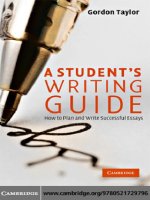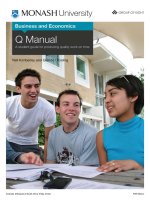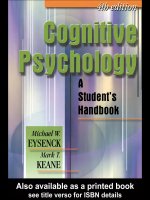A student’s writing guide
Bạn đang xem bản rút gọn của tài liệu. Xem và tải ngay bản đầy đủ của tài liệu tại đây (1.61 MB, 284 trang )
This page intentionally left blank
A Student’s Writing Guide
Are you struggling to meet your coursework deadlines? Finding it
hard to get to grips with your essay topics? Does your writing
sometimes lack structure and style? Would you like to improve your
grades? This text covers everything a student needs to know about
writing essays and papers in the humanities and social sciences.
Starting from the common difficulties students face, it gives practical
examples of all the stages necessary to produce a good piece of
academic work:
r
interpreting assignment topics
r
drawing on your own experience and background
r
reading analytically and taking efficient notes
r
developing your argument through introductions, middles
and conclusions
r
evaluating and using online resources
r
understanding the conventions of academic culture
r
honing your ideas into clear, vigorous English.
This book will provide you with all the tools and insights
you need to write confident, convincing essays and coursework
papers.
g o r d o n t a y l o r is Honorary Research Associate at Monash
University; before his retirement he was Associate Professor and
Director of the Language and Learning Unit in the Faculty of Arts
there. He was a pioneer in the development of content- and
discipline-specific writing programmes for students in higher
education. His many publications include The Student’s Writing
Guide for the Arts and Social Sciences (1989).
A Student’s
Writing Guide
How to Plan and Write Successful Essays
GORDON TAYLOR
CAMBRIDGE UNIVERSITY PRESS
Cambridge, New York, Melbourne, Madrid, Cape Town, Singapore, São Paulo
Cambridge University Press
The Edinburgh Building, Cambridge CB2 8RU, UK
Published in the United States of America by Cambridge University Press, New York
www.cambridge.org
Information on this title: www.cambridge.org/9780521729796
© Cambridge University Press 2009
This publication is in copyright. Subject to statutory exception and to the
provision of relevant collective licensing agreements, no reproduction of any part
may take place without the written permission of Cambridge University Press.
First published in print format 2009
ISBN-13
978-0-511-54002-8
eBook (EBL)
ISBN-13
978-0-521-72979-6
paperback
Cambridge University Press has no responsibility for the persistence or accuracy
of urls for external or third-party internet websites referred to in this publication,
and does not guarantee that any content on such websites is, or will remain,
accurate or appropriate.
For Kasonde, Susan and Jeremy
Contents
Preface xi
Sources of extracts used in the text
1
1
2
3
4
5
xv
Introduction 1
The main elements in academic writing 2
You and your writing task 4
You and your subject matter 7
You and your reader 12
Your language: form and structure 15
Part I Reflection and Research 19
2
1
2
3
4
5
Reflection: asking questions and proposing answers 21
Speculative thinking and writing 22
Choosing a topic 24
Kinds of question 27
Coming to terms with an essay topic 35
Summary 51
3
1
2
3
4
5
6
7
Interpretation: reading and taking notes 53
The ‘problem’ of reading 54
Evidence, interpretation and fact 57
What an author does 65
An author’s major motives 69
Modes of analysis 77
An author’s structural intentions 79
Interpreting a difficult text 82
viii – Contents
Part II The Dynamics of an Essay 89
4
1
2
3
4
5
Introductions 91
The constituents of an essay 92
The constituents of an introduction 94
The use and misuse of introductory material 95
Setting out your case 98
Writing an introduction to a research paper 107
5
1
2
3
4
Middles 111
Some common problems 112
The uses of outlines 116
Expanding a case 117
Summary 133
6
1
2
3
Endings 134
Recapitulation 134
Mood: suggestion and implication
Variations on a theme 140
136
Part III Language 145
7
1
2
3
4
You, your language and your material 147
Subjective and objective: the uses of ‘I’ and ‘we’
Confusing yourself with your material 151
Quoting – and not quoting 161
Some verbs of enquiry: how to use them 163
8
1
2
3
Analytical language 1: sentences 167
Discrimination and confusion 168
Elements of sentence structure 169
Participants, processes and circumstances
9
1
2
3
Analytical language 2: rhetorical strategies
Analysing versus describing 194
Defining 199
Comparing and contrasting 207
177
194
148
Contents – ix
10 Cohesion and texture 215
1 Determinants of cohesion and texture 215
2 Revising and improving text 221
11 Conventions of academic writing 230
1 Academic culture 230
2 A skeleton key to stylistic conventions
Appendices
1 Writing book reviews 240
2 Sample analyses of essay topics
3 A revised manuscript 252
Index 257
243
232
Preface
When the first edition of this book was published I believed that it
could and should have a fairly limited life. This belief was founded on
the idea that, such is the closeness of language, thought and subject
matter, the future of such books would be based on the disciplines
of knowledge in the humanities and social sciences and that, consequently, the best people to write such a text were those who knew the
rhetoric of their own disciplines more intimately than a generalist ever
could. The teaching of a discipline, I have long held, should include
as an inalienable component the teaching of how to write in that discipline, just as the Roman scholar–statesman Cicero had inveighed in
his De Oratore against ‘that absurd, needless and deplorable conception, that one set of persons should teach us to think, and another
teach us to speak’.
To some extent this has come to pass – but only to some extent.
There are now student manuals on how to write in some disciplines,
particularly history, English literature, psychology, philosophy and
sociology. What I did not foresee is the extent to which many of the old
disciplinary boundaries have begun to blur, and the extent to which
new inter-disciplinary ‘studies’ subjects have come to characterise the
offerings of arts and social science faculties. Much in the climate of
thought (and rhetoric) has changed. As a result, there still seems to be
a good case for a general book such as this one, in which I have taken
the opportunity to engage with these new developments.
Moreover, many other things have moved on. The kinds
of essay topic now being set are often rather different from those
that used to be the staple in many courses; the kinds of tasks have
changed – particularly the opportunity now being given to undergraduate and course-work graduate students to devise and write
research papers; and, of course, there are many new problems as well
xii – Preface
as advantages posed by the ubiquitous use of the computer/wordprocessor and the internet.
Even so, there would probably have been no second edition
had it not been for a few terriers at my heels. Andrew Winnard of Cambridge University Press was a terrier with longer staying power than
is usually found, ably abetted by colleagues at Monash University,
Tim Moore and David Garrioch, whose encouragement and continuing assistance have been crucial. In getting up to speed with the more
recent kinds of essay topics and many other things, I would have
languished without the immense assistance of Steve Price, Matthew
Piscioneri, Andrew Johnson and Jim Hlavac. To those many academics
whose essay topics I have used for illustrative purposes I wish here to
record my indebtedness. There are many books on the history of Jews,
Muslims and Christians in mediaeval Spain (see chapter 3), but it was
Constant Mews who pointed me to and lent me a more suitable text
for my purpose, Maurice Glick on Convivencia. To Keith Allan, Marko
Pavlyshyn and the School of Languages, Cultures and Linguistics at
Monash University I owe a great debt for smoothing my path. Finally,
Kate Brett, commissioning editor at Cambridge University Press, has
been my constant guide for the life of this project.
Much of the emphasis in this book (as it was in the first
edition) is on what writers (both you the student and the writers of
the sources you use) do with their language. Your attention is drawn
to this throughout the text by the use of small capitals.
Preface to the original 1989 edition of The Student’s
Writing Guide for the Arts and Social Sciences
This book has grown out of a writing course I have taught for some
years to students of the arts and social sciences. In both I have tried to
emphasise the close connections between writing in these disciplines
and grappling with the problems of knowledge and understanding
they present. Writing is not merely a skill we employ to record our
knowledge, but the very moment at which we confront what learning
and understanding are all about. So, while the reader will surely find
plenty of guidance on the practical issues that arise in writing an
Preface – xiii
academic essay, a search in these pages for simplified techniques that
side-step the very taxing work of coming to terms with knowledge
and method in these disciplines will be fruitless. My project has been
to clear paths, not to indicate short cuts.
It has been my experience that many students’ writing problems arise from uncertainty about what it is they are trying to say
and what it is they have to do. So far as is possible in a general work
of this kind, I have attempted to establish, in a variety of representative disciplines, some of the connections between issues of content
and the forms of language in which the content can be realised. I am
conscious that there are arts and social science disciplines which have
not received extended treatment in the examples. But I trust that in
concentrating attention on some of the most important things that
we do with language in academic studies I have been able to direct
readers to the kind of thing to look for in the particular disciplines
they are studying.
The book is divided into three parts. I suggest the chapters
of Parts I and II be read through at least once in the order presented.
In this way the student will get a general idea of how to approach
the writing of an academic essay. Not everybody approaches writing
and learning in quite the same fashion, so it is important that the
suggestions in Parts I and II be interpreted in a way that works
best for the individual reader. The chapters of Part III contain in
many instances extensions of themes introduced earlier, but they can
also be read as more or less self-contained introductions to particular
problems in the use of language. For the most part, grammatical and
other details of language use are dealt with not in the manner of the
conventional guides to usage but as they arise in those contexts of
meaning we concentrate on as we write. It will therefore be necessary
to make good use of the index. Part III is not a comprehensive guide to
the language of academic discourse. I have chosen to treat only those
features of language which students often question me about, those
which in my estimation cause most trouble, and those which (spelling
apart) tutors most regularly draw attention to in their marking of
essays.
The book has been some time in the gestation. To John
Clanchy, Brigid Ballard and Elaine Barry I owe many thanks for their
xiv – Preface
encouragement and for commenting on drafts which they have now
probably forgotten. I. W. Mabbett helped me greatly to clarify my
thinking on some of the material in chapter 3, and the readers of
the Cambridge University Press have made this a better book than
it would otherwise have been. My students have contributed much:
not only have they let me use their work, they have pushed me to
understand certain things about writing I would never have gleaned
elsewhere. But it is on the person who, as the psalmist says, can
‘alway keep judgement’ and who has believed in this book when I
didn’t myself that I have depended most – my wife Angela.
Sources of extracts used in the text
Dwight Bolinger, Language – the Loaded Weapon. London and New
York: Longman, 1980.
R. N. Campbell and R. J. Wales, ‘Comparative structures in English’.
Journal of Linguistics, 5:2 (1969), pp. 215–51.
E. H. Carr, What is History? Harmondsworth: Penguin, 1964.
Manning Clark, A Discovery of Australia. The Boyer Lectures. Sydney:
Australian Broadcasting Corporation, 1976.
A. C. Ewing, A Short Commentary on Kant’s ‘Critique of Pure Reason’.
Chicago: University of Chicago Press, 1938.
Thomas F. Glick, ‘Convivencia: an introductory note’. In Vivian B.
Mann, Thomas F. Glick and Jerrilynn D. Dodds (eds.) Convivencia:
Jews, Muslims, and Christians in Medieval Spain. New York: George
Braziller Inc., 1992, 2007.
Sharon E. Hutchinson, Nuer Dilemmas: Coping with Money, Wars and
the State. Berkeley and Los Angeles: University of California Press,
1996.
Immanuel Kant, Critique of Pure Reason, trans. Norman Kemp Smith.
New York: St Martin’s Press, 1965.
F. R. Karl and L. Davies (eds.) The Collected Letters of Joseph Conrad,
vol. I. Cambridge: Cambridge University Press, 1983.
Norman Kemp Smith, A Commentary to Kant’s ‘Critique of Pure Reason’, 2nd edn. New York: Humanities Press, 1962.
F. R. Leavis, ‘Two cultures? The significance of Lord Snow’. In Nor
Shall My Sword: Discourses on Pluralism, Compassion and Social Hope.
London: Chatto and Windus, 1972.
xvi – Sources of extracts used in the text
James Luchte, Kant’s Critique of Pure Reason: a Reader’s Guide. London
and New York: Continuum, 2007.
Walter Nash, Designs in Prose. London: Longman, 1980.
A. R. Radcliffe-Brown and D. Forde (eds.) African Systems of Kinship
and Marriage. London: Oxford University Press, 1950.
W. G. Runciman, ‘What is structuralism?’ In Alan Ryan (ed.) The
Philosophy of Social Explanation. London: Oxford University Press,
1973.
George H. Sabine, A History of Political Theory, 3rd edn. London:
George G. Harrap, 1963.
John B. Whittow, The Penguin Dictionary of Physical Geography.
London: A. Lane, 1984.
John M. Wilding, Perception, From Sense to Object. London: Hutchinson, 1982.
1
Introduction
How do I know what I think till I see what I say.
E. M. Forster
How do I know what I’ll say till I see what I think.
Anon.
This chapter is designed to help you think about how you
fit in to the broad culture of academe and the kind of
writing it asks for. It is about
r
how to avoid procrastinating and how to discover a real
desire or ‘itch’ to write
r
how to gain a sense of confidence that you are making
tangible progress with each piece of work you begin
r
how to value your beliefs, prejudices, experiences and
past learning as a springboard for producing considered,
well-argued and adequately researched judgements
r
how to relate in writing and in person with your
audience – the tutors who examine your work, their
expectations, academic traditions and foibles
r
how, despite the difficulties, you can come to really enjoy
using language to articulate your thoughts and ideas.
2 – Introduction
1
The main elements in academic writing
If we are to write well we need to know (as well as we can) what
we are talking about. In order to find out what, precisely, we are
talking about we need to write. Pushing ourselves to write will often
reveal that we know more about a subject than we at first supposed; it
should just as often reveal large gaps in our understanding of matters
we thought ourselves fairly sure of. In writing we bring knowledge
into being, we record and preserve it. Writing is the seed, the fruit
and the pickle of our understanding.
Most people in the English-speaking world used to think that
the student’s and scholar’s mind is an empty bucket to be filled by
books, lectures and tutorials. Nowadays neuroscientists and psychologists tell us that the brain doesn’t work in this passive, accepting
manner. On the contrary, to learn and to write is, first, to make sense
for ourselves of our new experience in terms of our old. So you need
to be aware at the outset that, even to subjects you have never studied before, you can bring certain preconceptions, even prejudices, a
certain amount of disjointed knowledge, and a certain facility with
language – all of which can get you started. The most baffling of essay
topics can soon yield some meaning if you take the initiative and begin
to ask quest io ns – of yourself, of the essay topic, of your books
and lectures, of the school or department for whom you are writing
the essay. To think of yourself as an active enquirer, rather than as
a mere receptacle of ideas and knowledge or as a passive medium by
which they are transmitted from your books to your essays, is essential to good essay-writing. Good academic writing actually creates new
knowledge and new meaning.
Now there is no single technique by which this can be
achieved. Rather, there seem to be four elements whose relationships with one another need to be balanced: the writer, the object
of the analysis or discussion (the content), the reader, and the formal
properties of the language itself. Not everybody will balance these
elements in quite the same way; and this is as it should be, since there
is no such thing as a uniform, ideal academic English. Getting the
balance right will depend partly on how you, the writer, respond in









